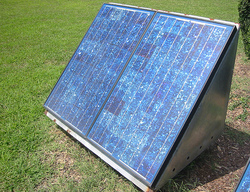Home solar panels just seem to lie around all day doing nothing.
Think about what you see when you look at a solar panel.
No moving parts, no lights, no bells, no whistles. No sign at all that any work is getting done.
Yet these panels produce enough power to light up our homes, run our televisions, toast our bagels, and maybe even make our electrical meter run backwards.
So where is all that power coming from?
Well, let’s take a quick look at a day in the life of a home solar panel.
6:00 AM – The sun hasn’t risen yet and all is quiet. Our solar panel rests peacefully on our rooftop, not yet producing any electricity.
7:00 AM – Sunrise! As our little solar power party gets started, the first few guests (sunbeams) begin to arrive.
The sunbeams shine onto the solar cells in our panel and this is the process that occurs:
- A certain portion of the light is absorbed by the solar cell’s semiconductor material (usually silicon)
- The energy of the light knocks electrons loose, causing them to move freely
- An electric field forces the electrons to flow in a certain direction, creating a current
- The current is drawn out of the solar cell through metal contacts
- The current (combined with the cell’s voltage) create the power that can light our homes and charge our iPads
10:00 AM to 2:00 PM – The sun rises to its highest point in the sky and our solar power party gets into full swing. More sunlight hits the panel, more energy knocks loose more electrons, and more power is available to light up our TV and allow our Maury Povich marathon to continue (I can’t believe he’s not the father!).

3:00 PM to 6:00 PM – The sun begins to sink back down toward the horizon and our party begins to wind down. By sunset all is quiet again and our solar panels are ready to rest for another night.
That is a simplified version of a day in the life of a home solar panel.
What’s that? You’d like to know more about the science behind our little solar power party?
Oh boy.
Well, remember silicon, the semiconductor material that our solar cells are made of?
It turns out that the outer orbit of an atom of silicon is only half full. To fill this void, a silicon atom joins up with four other silicon atoms.
The resulting crystalline structure is not a very good conductor of electricity so the silicon in our solar cells is combined with phosphorus and boron.
When the silicon mixed with phosphorus meets the silicon mixed with boron an electric field is created. Then sunlight hits our solar panel and knocks electrons loose. The electrons follow the external path we provide for them so they can return to their original side of the solar cell.
When the electrons are following the external path we make them do a little work (e.g. lighting lights) before they can return to their “home”.
So this is how a home solar panel powers our home (even though it looks like it’s just lazing in the sun).
